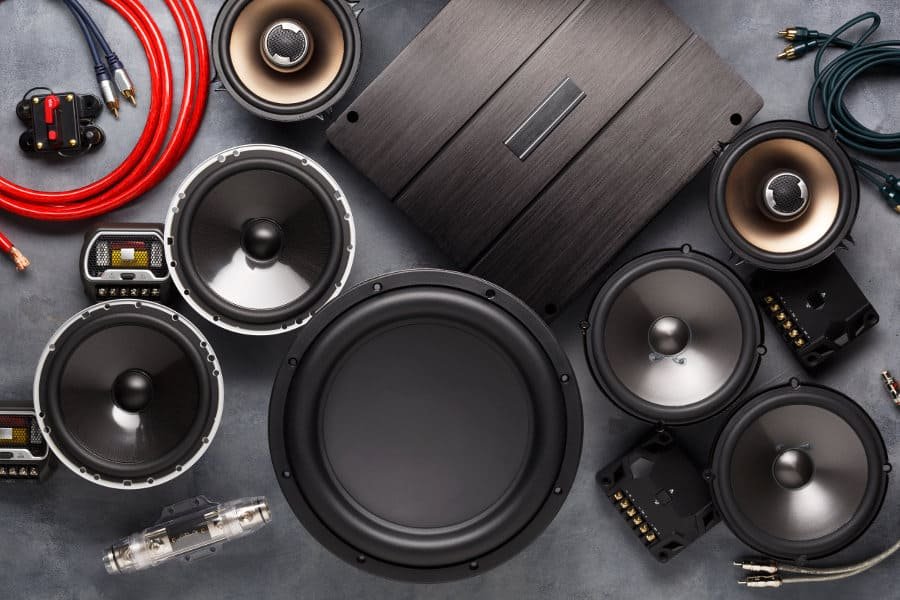Subwoofers are an integral part of any stereo system, both small and big. However, over time, due to certain connection errors and improper installation, subwoofers rattle and produce some unpleasant sounds. Solving a rattling car subwoofer is necessary for enjoying the optimal audio in-car performance. Why does my car subwoofer rattle and how to solve it?
Loose, underpowered, and overpowered connections are antecedents for car subwoofer rattling. Other reasons include improper or poor installation, visible damage, poor wiring, and wear and tear. Rattling is a common problem with car subwoofers. Nonetheless, there are numerous solutions to prevent and stop the rattling sound from your car subwoofers.
Before tossing out your car subwoofers, we recommend searching for an inexpensive solution, such as quick repairs and or inexpensive upgrades. Below are specific reasons why car subwoofers rattle and how to solve each problem.
Table of Contents
How To Locate The Source Of Subwoofer Rattling
Motorists are spending huge amounts of money on subwoofer repairs, and that’s because they are repairing the wrong component. Before moving ahead with implementing any repairs or buying new components, you need to identify the source of the problem.
While it’s not uncommon for underpowered subs to rattle, other causes such as a broken sub connector can affect your audio output.
The best to identify the source of subwoofer rattling is by playing bass audio at high volume to test for distortion of rattling. Inspect the subwoofer closely while playing the bass audio and search for the source of the rattling.
The major sources of rattling are damaged cones and loose screws. How do you solve these problems? Simply by padding in between the speaker cabinet and woofer
Causes of Rattling Subwoofers
Loose Components
The most commonly sighted reason for rattling is loose components and connections, within and outside the subwoofer. Sound distortion and rattling are only a by-product of loose voice coils, gaps, and cones. If you want to enjoy high quality, you may want to consider checking for loose connections and components first.
Fixing loose components is quite difficult and can be stressful as motorists would need to take the subwoofer off, piece by piece. But that’s what is required to uncover the loose component.
However, check the sub-cabinet before taking off your equipment piece by piece. Loose screws on the cabinet also cause rattling. Tighten the screws and add more to ensure the unit is tightly held together.
Inspect your subwoofer at least once a week because vibrations are the number one enemy of screws. Vibrations loosen even the tightest screws. To avoid the effects of vibrations from a subwoofer, use high-quality screws and fasten them tightly.
If after taking out the subwoofer piece by piece and applying extra tight screws, the rattling continues, replacing the voice coils might be your best option. You can replace the damaged voice coil with an old amplifier in your garage or buy a new one here.
Take caution while unscrewing your subwoofer to avoid further damage. You want to hire the services of a professional if you’re unsure of the screws to remove or the components to inspect.
Overpowered Subwoofer
Subwoofers have different power ratings and come with a corresponding power cable. While size may determine to a lesser degree the volume of a subwoofer, power ratings are what determines how much load the subwoofer can actually handle.
While it may be a good idea to enhance your stereo system with advanced amplifiers, you want to always make sure that your subwoofer is equipped to handle high volumes.
Turning your amplifier volume up or tweaking the gain too much may result in distortion or rattling. Monitor the output from the subwoofer as you tweak the knobs on your amplifier.
Notice any distortion or rattling, tune it down. Forcing your subwoofer to power higher volumes than what’s allowed by the components will result in damage, such as a torn cone or damaged voice coil.
Obey the RMS ratings rather than the peak maximum rating. RMS ratings are more secure and accurate, unlike peak ratings that have no exact limits. You’ll find out that RMS ratings are much lower than peak ratings. Using RMS ratings enhances the durability of your subwoofer.
Underpowered Subwoofer
As it is with overpowered subwoofers, underpowered subs can also cause distortions and rattlings. Most of the problems from underpowered subs are from the amplifiers.
Amplifiers also have their limits and any voltage above the limit will result in clipped signals. This reduces the quality of the sound output from your subwoofer.
Instead of a sinusoidal waveform, the clipped signal produces a square waveform which moves the cone faster than usual. This rapid movement can damage the cone and the entire sub.
Either upgrade your amplifier to handle higher voltage or use it at a minimum volume to protect your subwoofers.
Did nothing work? Then hire the services of a professional to check your subwoofer. You might also want to consider replacing the subwoofer with a new and improved subwoofer here. However, always check the power ratings and compatibility before making a purchase. After installing new subwoofers, check for vibrations. Make sure it isn’t vibrating too much to ensure that the screws don’t fall off.
Place your subwoofers in safe areas. Avoid spillage and facilitate maximum ventilation to prevent overheating. You should also adjust the settings on your car amplifier. Lower the volume to match the power ratings and avoid using the gain knob as a volume button.
Tips For Maintaining Your Car Stereo
The key to distortion-free audio output is proper and regular maintenance. Use your stereo under the right conditions and keep it away from hazardous elements. Here are the best tips to extend the lifespan of your stereo and car subwoofers.
-
Proper Installation
Most stereo and subwoofer problems stem from incorrect installations. While the installation of stereo and subwoofers are fairly easy, it’s quite easy to make small mistakes that could affect sound output and the stability of your stereo system.
An important installation aspect to look at is wiring. Use the correct cable type and run the wires through inconspicuous areas of your vehicle. Use flexible wires if you’d be running long installations.
While reverse polarity does not affect sound output, it is recommended to ensure correct polarity. Plug the subwoofer positive cables to the positive terminal on the amplifier and do the same with the negative cables.
While installation is simple, you may want to invest in a professional stereo installation by hiring a professional audiophile. Or simply follow the instructions from the manufacturers.
Avoid using inferior cables or matching wrong ratings together.
-
Keep Subwoofers Clean
Dust and liquid should be kept as far away as possible from your subwoofer and entire stereo system. This is because dust and liquid can damage electronics. Clean spills immediately with a damp cloth or vacuum with dry/wet vacuum.
Handheld vacuum cleaners are also efficient at removing dust from your subwoofer. Keep your subwoofer away from liquid. Either install it in a safe place or cover it with a good box.
By keeping your subwoofer clean all the time, you guarantee an extended lifespan and ensure high sound quality. Check with your manufacturer for the recommended cleaning agent.
-
Don’t Overdrive Your Stereo
The gain knob is not the volume button. The gain volume should be proportional to the output level of your stereo. The best way to set up your gain is by tuning it up to 75% and gradually increase the volume until you hear distortion. Distortion kills the quality of music, so we need to do everything to avoid even the slightest distortion.
Always know the limitations of your subwoofer and stereo system. Don’t increase the volume above what the sub and amplifier can handle and always match the power ratings. Check your connections from time to time. And if your subwoofer is constantly vibrating, then you’ll also need to look out for loose components.



